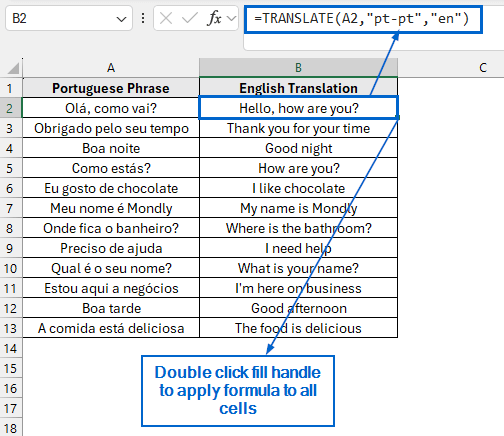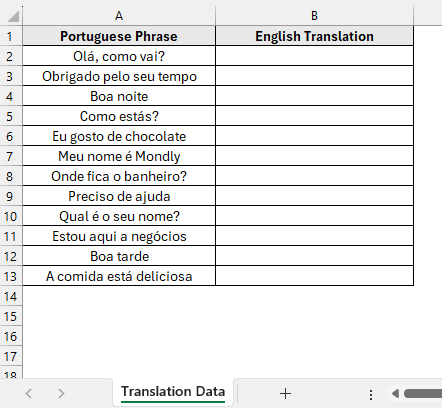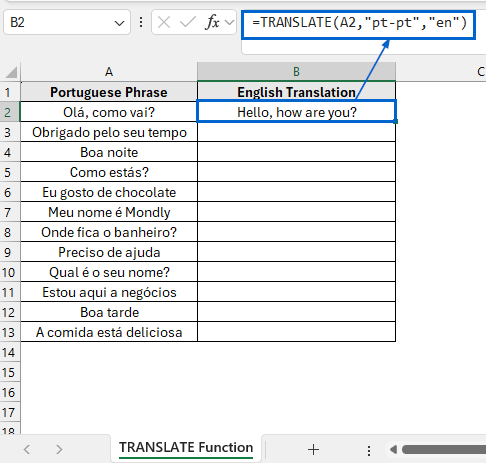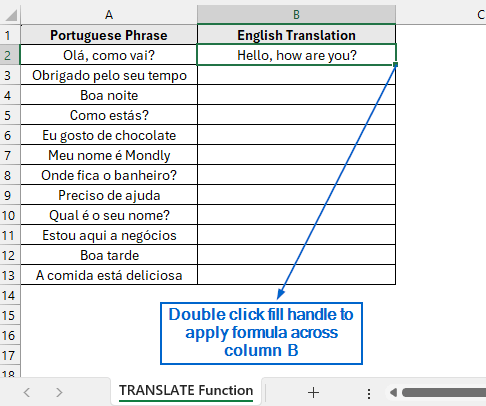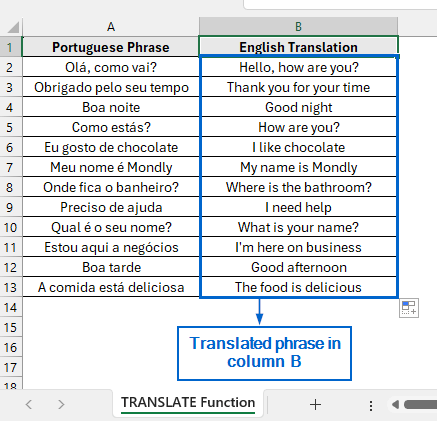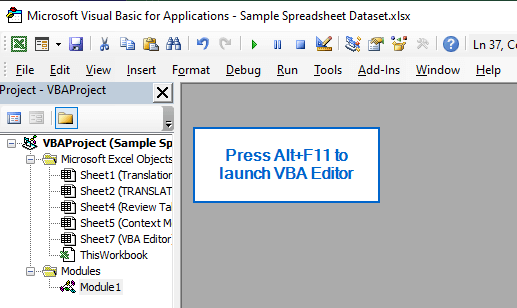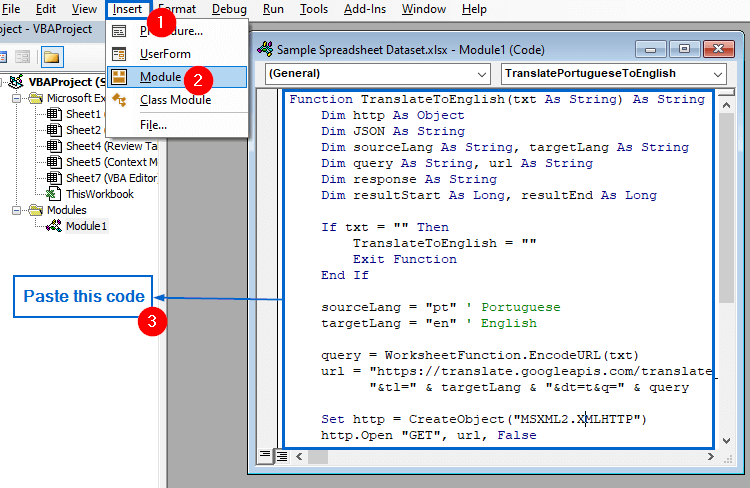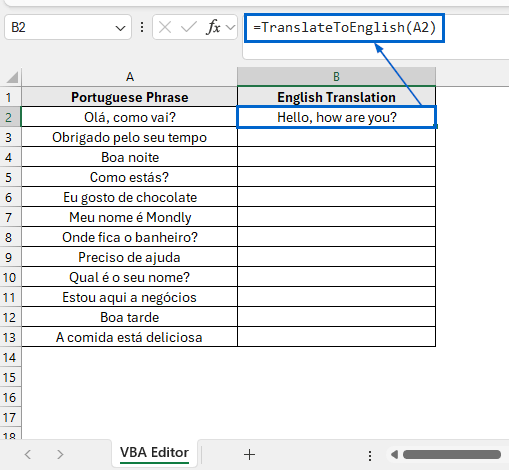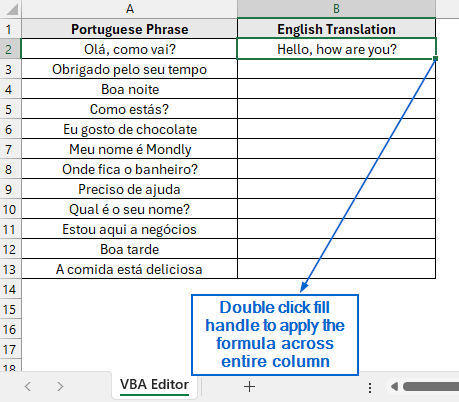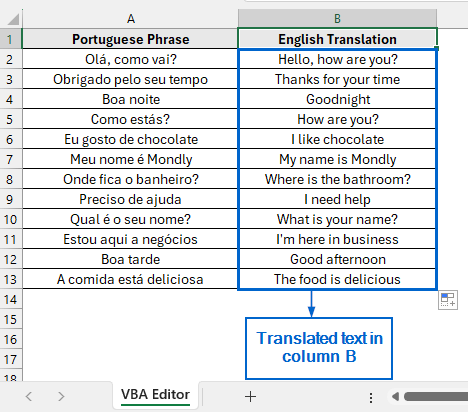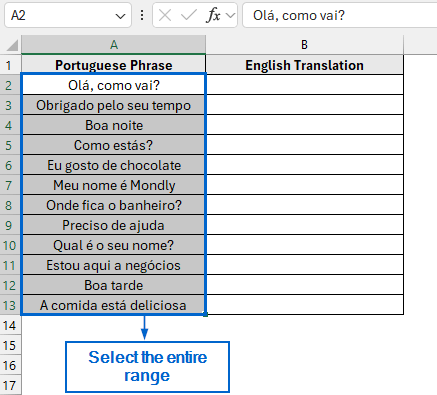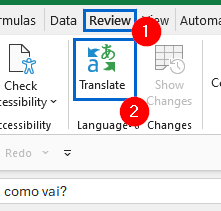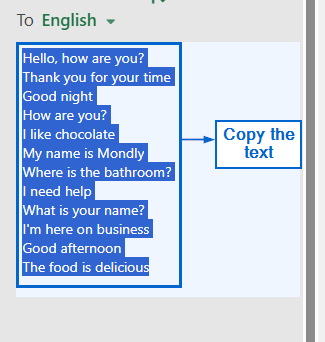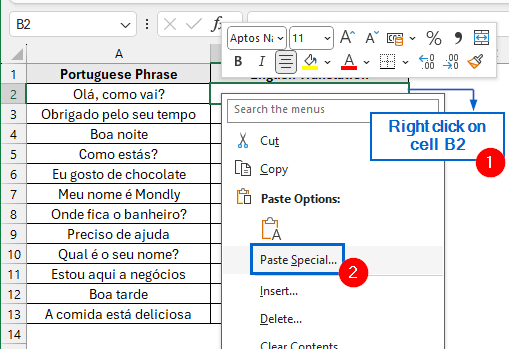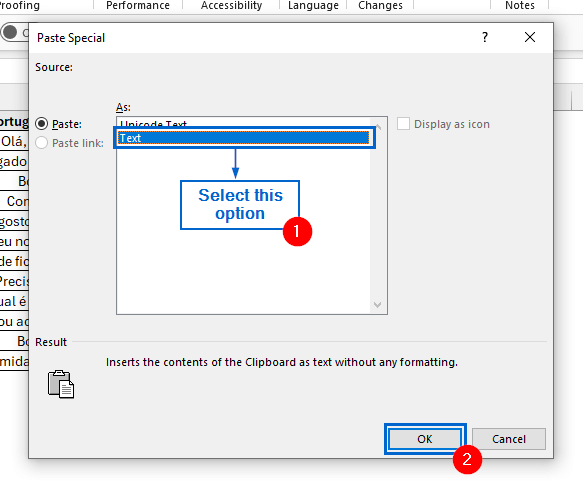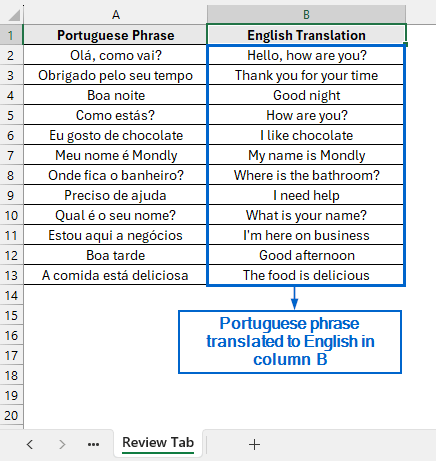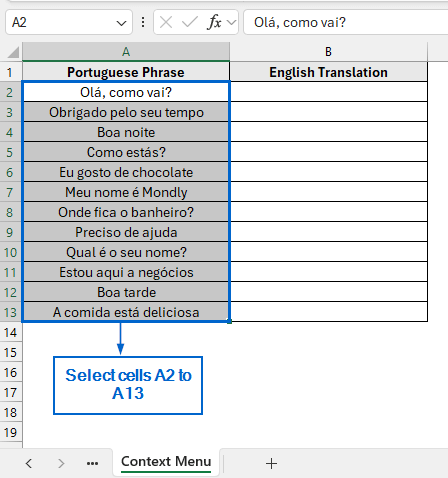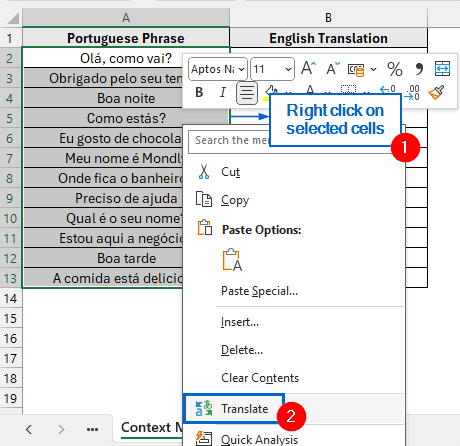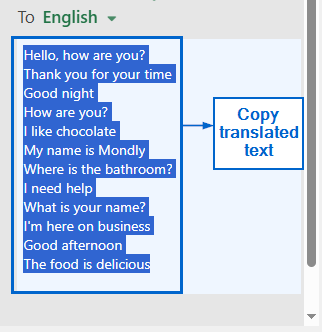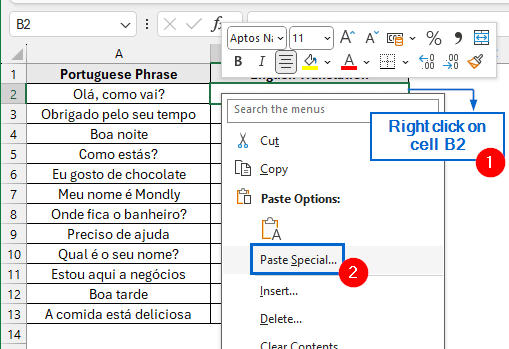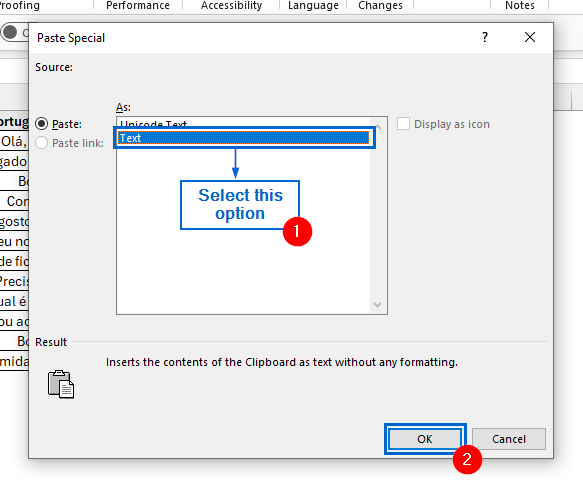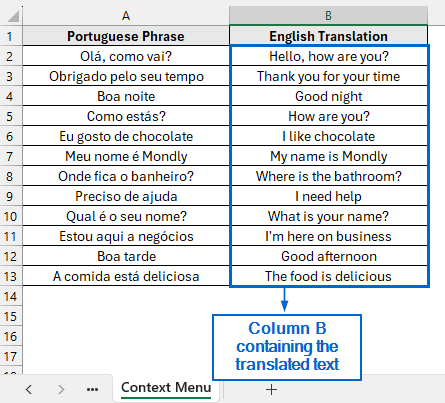If you often work with multilingual datasets, it is essential for you to know how to translate Portuguese to English. By using Excel’s built-in translation functions and tools, you can easily convert Portuguese text into English directly within your worksheet.
Follow the steps below for translating Portuguese to English in Excel:
➤ In your dataset, select the cell where you want to display the translated data and paste the following formula:
=TRANSLATE(A2,”pt-pt”,”en”)
➤ Replace A2 with the cell containing the Portuguese text you want to translate.
➤ Replace “pt-pt” with the source language code (In our case, we chose “pt-pt” since we want to translate from Portuguese)
➤ And finally, replace “en” with the target language code you want the text translated into.
In this article, we will learn four effective methods of translating Portuguese to English in Excel.
Translate Portuguese to English Using the Built-in TRANSLATE Function
In the sample dataset, we have a worksheet named Translation Data where column A contains Portuguese phrases and column B, labelled English Translation, is currently empty. By using the TRANSLATE function, we will convert the Portuguese phrases in column A into English and display the results in column B. The updated dataset will be displayed in a separate worksheet called TRANSLATE Function.
The TRANSLATE function in Excel is a handy tool which allows users to translate text from one language to another within a worksheet.
Steps:
➤ Open the TRANSLATE Function worksheet and in cell B2, put the following formula:
=TRANSLATE(A2,"pt-pt","en")
➧ A2 is the cell containing the text that we want to translate.
➧ "pt-pt" specifies the source language, which is Portuguese.
➧ "en" is the target language, which is English.
➤ Next, select cell B2 again and double-click the fill handle to apply formula across column B.
➤ The translated phrase should now be displayed in column B.
Translate Directly Using the VBA Editor
The VBA Editor is a powerful tool in Excel that is used to write, edit, and manage VBA code, allowing users to automate repetitive tasks, create custom functions, and develop complex macros.
Working with the same dataset, we will use the VBA Editor to translate the Portuguese phrase to English and display it in column B of the worksheet. We will display the modified dataset in a separate worksheet called VBA Editor.
Steps:
➤ Open the VBA Editor worksheet and press Alt + F11 to launch the VBA Editor window.
➤ From the main menu, head to Insert >> Module and paste the following code:
Function TranslateToEnglish(txt As String) As String
Dim http As Object
Dim response As String
Dim sourceLang As String, targetLang As String
Dim query As String, url As String
Dim resultStart As Long, resultEnd As Long
If txt = "" Then
TranslateToEnglish = ""
Exit Function
End If
sourceLang = "pt"
targetLang = "en"
query = WorksheetFunction.EncodeURL(txt)
url = "https://translate.googleapis.com/translate_a/single?client=gtx&sl=" & sourceLang & "&tl=" & targetLang & "&dt=t&q=" & query
Set http = CreateObject("MSXML2.XMLHTTP")
http.Open "GET", url, False
http.Send
response = http.responseText
resultStart = InStr(1, response, """") + 1
resultEnd = InStr(resultStart, response, """")
If resultStart > 0 And resultEnd > resultStart Then
TranslateToEnglish = Mid(response, resultStart, resultEnd - resultStart)
Else
TranslateToEnglish = "Error"
End If
End FunctionNote:
This VBA code uses Google Translate’s API to automatically translate Portuguese text into English by sending the text to the online service and retrieving the translated result in Excel.
➤ Next, press Alt + Q to return to Excel, select cell B2 and put the following formula:
=TranslateToEnglish(B2)
Note:
This formula uses the custom VBA function TranslateToEnglish to automatically translate the text entered in cell B2 from Portuguese to English.
➤ Then, select cell B2 again and apply the formula across the entire range by double-clicking the fill handle.
➤ You should now see the translated text in column B of the dataset.
Translate Portuguese to English Using Excel’s Review Tab
Excel’s Review tab provides a wide range of features, including the Translate tool, which allows users to translate Portuguese text into English easily. Working again with the same dataset, we will use the Translate tool from the Review tab to convert the Portuguese phrases into English. The modified dataset will be displayed in a separate Review Tab worksheet.
Steps:
➤ Open the Review Tab worksheet and select the range A2:A13.
➤ From the main menu, head to Review >> Translate.
➤ Now, from the Translator pane, select and copy the translated English text.
➤ Next, select cell B2, right-click your mouse, and from Paste options select Paste Special.
➤ From the Paste Special dialogue box, select Text and then click OK.
➤ The translated Portuguese phrase to English should now be visible in column B.
Translate Portuguese to English Using the Context Menu
The Context menu in Excel is a quickly accessible tool that appears when you right-click a cell, offering a range of useful actions, including the ability to translate text instantly. It performs the same task as the previous method but offers the added benefit of quicker access and faster operation.
Again, working with the same dataset, we will translate the Portuguese phrase to English using the context menu and display it in column B of the dataset. We will display the updated dataset in a separate Context Menu worksheet.
Steps:
➤ Open the Context Menu worksheet and select cells A2 to A13.
➤ Right-click on the selected cells to open the context menu, then click Translate.
➤ Now, copy the translated text from the Translator pane by pressing Ctrl + C .
➤ Then, click on cell B2, right-click to open the context menu, and choose Paste Special from the list.
➤ Next, select Text from the list in the Paste Special dialogue box, then click OK.
➤ You should now see the translated Portuguese phrase in English displayed in column B.
Frequently Asked Questions
Will These Methods Work Without an Internet Connection?
Yes, most of the methods discussed in this article will work perfectly without an internet connection, except for the VBA Editor. Since the VBA script relies on Google Translate’s online API to fetch the translated text, an active internet connection is essential for this method to function.
Which Method Should I Use For Translating Large Datasets?
If you are dealing with a large dataset and need to translate it efficiently, the TRANSLATE function and the VBA Editor method would be the best. The TRANSLATE function is formula-based, making it faster and ideal for structured data. On the other hand, VBA Editor automates the translation process by connecting directly to Google’s servers, allowing users to process large datasets with minimal effort.
Concluding Words
Knowing how to translate Portuguese to English in Excel is a must for dealing with multilingual datasets and streamlining workflows. In this article, we have discussed four effective methods of translating Portuguese to English, including using the TRANSLATE Function, VBA Editor, Review Tab and Context Menu. Feel free to try out each method and select one that best aligns with your needs.

